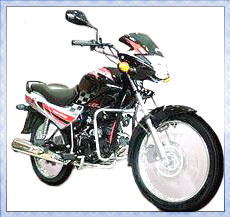BRAKING: Effective braking is one key to going fast on the track, and is extremely important in your quest to stay alive on the street. The only way to improve your braking skills is to continually practice. This is one reason why racing or riding on a track is so beneficial - you are constantly using your brakes to their fullest potential.
The biggest question you must answer is whether you are going to use both brakes, or just the front. While most beginner riders rely heavily on the rear brake, it is fairly well known by now that it is your front brake that provides most of your stopping power. The reason for this is that during heavy braking, very little weight remains over the rear wheel, and it is very easy to lock up. The front wheel meanwhile, has most of the weight, and can therefore be subjected to a hard squeeze on the lever. Notice I said SQUEEZE and not, GRAB.
When I am racing, I only use the front brake. I have tried using both, but the trouble I seem to get into is not worth the potential gain. I realize that most of the very top riders use both brakes, but I had trouble modulating both levers while doing everything else that is necessary to set up for a corner.
Anyway, it is a personal choice. Try it both ways and use what is best for you.
Proper braking technique when using only the front brake:
1- roll off the throttle
2- “settle” the front end by applying moderate pressure
3- squeeze the front brake lever firmly, decreasing pressure as you slow down.
NOTES: Settling the front end is the process of transferring weight to the front wheel. Once there is a forward weight bias, you can squeeze the brake lever very firmly. As your speed decreases, the amount of force on your front wheel decreases, and you need to reduce lever pressure to avoid locking up the wheel. Do NOT worry about flipping over the handlebars. It takes a certain skill to do a "stoppie". IT WILL NOT HAPPEN BY ACCIDENT.
 The higher your speed, the harder you can squeeze the lever without risk of locking up the wheel. If you feel the wheel lock up, quickly reduce pressure momentarily, and then continue to squeeze firmly. You don't need to completely let go of the lever, simply reducing the pressure will allow the the wheel to regain its traction. Never jerk the lever back. Always squeeeeeze!!
The higher your speed, the harder you can squeeze the lever without risk of locking up the wheel. If you feel the wheel lock up, quickly reduce pressure momentarily, and then continue to squeeze firmly. You don't need to completely let go of the lever, simply reducing the pressure will allow the the wheel to regain its traction. Never jerk the lever back. Always squeeeeeze!!
Proper braking technique using both brakes:
1. Roll off the throttle;
2. Apply the brakes simultaneously to settle the bike;
3. Increase front lever pressure as you decrease rear pedal pressure;
4. As your near a stop, decrease front lever pressure and increase rear pedal
pressure, if necessary.
NOTES: When you initially apply the brakes, there is almost a 50/50 weight bias. As most of your weight transfers to the front wheel, you must lessen your pressure on the rear pedal, or it will lock up. In order to continue stopping, however, you must increase front lever pressure. As you near a stop, your weight begins to transfer backwards, and you can once again apply more pressure to the rear.
When the expert riders at SPORT RIDER did a test, they got the following results:
REAR BRAKE ONLY: 289 FEET
FRONT BRAKE ONLY: 151 FEET
BOTH BRAKES: 146 FEET
As you can see, there is a big drop going from REAR ONLY to FRONT ONLY, but a much smaller drop going to BOTH. Once again, its up to you to decide.
Proper, hard braking is the key to fast lap times on the track. On the street, knowing how quickly you can stop can save your life (or at least your bike).
Other braking tips:
- Maximum braking can only be done while straight up and down.
- If you are in a corner and need to scrub off a lot of speed, remember
this saying - STOP TURNING and START STOPPING. Once your
speed is under control, quickly begin turning again. - On the street, leave yourself an out. Don’t go into a corner so fast that if the road
is blocked, you will not be able to come to a stop. - The same procedures work if it is raining. I tend to use a little more rear brake when
I am riding on the street in the rain. On the track, I still use all front brake. - Practice your braking. Go to an empty parking lot. Make sure there is not a lot of
sand or debris, and try to avoid painted lines. Pick out two “lanes”, and go back
and forth, each time trying to stop a little sooner. Try using one brake, then both
brakes. - Decide how many fingers you want on the brake lever. Most racers use only the first
two fingers. This provides ample power, but still leaves them two fingers to
“blip” the throttle. This is when you crack the throttle slightly before each downshift
to better match the engine speed with the rear wheel.









































